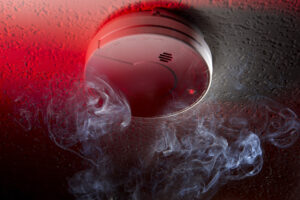Smoke Detectors
WHAT CAN I DO ABOUT MY HOME’S SAFETY FOR SMOKE AND FIRE PROTECTION?
One of the most overlooked safety devices in your home is a smoke detector. Simply put, a smoke detector is a device that is used to detect smoke. There are basically two types of smoke detector systems, one that has smoke detector wiring that issues a signal to a monitored fire alarm system, and the other, known as smoke alarms, generally issue a local audible and/or visual alarm from the detector itself.
Smoke detectors are typically housed in a disk-shaped plastic enclosure, but the shape may vary by manufacturer or product line. Most smoke detectors work either by optical detection (photoelectric) or by physical process (ionization), while others use both detection methods to increase sensitivity to smoke. Smoke detector wiring can be powered by a central fire alarm system, which uses a battery backup, or as is the case in many single-family detached and multi-family homes, a smoke alarm is powered only by a single disposable battery.

INSTALLATION AND PLACEMENT
Smoke detectors are generally placed where they will do the most good. In the United States, most state and local laws regarding the required number and placement of smoke detectors are based upon standards established in the National Fire Prevention Association (NFPA 72) fire code. Laws governing the installation of smoke detectors vary from jurisdiction to jurisdiction. The United States requires smoke detectors on every habitable level and in attics that are accessible and within the vicinity of all bedrooms.
In new construction, minimum requirements are typically more stringent. All smoke detector wiring must be hooked directly to the electrical wiring system, be interconnected and have a battery backup. Some jurisdictions also require smoke detectors in stairways, main hallways, and garages.
Wired units allow a dozen or more detectors to be connected so that if one detects smoke, the alarms will sound on all the detectors in the network, improving the chances that occupants will be alerted, even if they are behind closed doors or if the alarm is triggered one or two floors removed from their location. Smoke detector wiring with interconnections may only be practical for use in new construction, especially if the wire needs to be routed in areas that are inaccessible without cutting open walls and ceilings.
BATTERY BACKUP
Most residential smoke detectors run on 9-volt alkaline or carbon-zinc batteries. When these batteries run down, the smoke detector becomes inactive. When the battery is low, most smoke detectors will signal with a chirping sound at regular intervals. In regions that observe daylight saving time, public awareness campaigns suggest changing the smoke detector batteries when they change their clocks.
Some detectors are also being sold with a lithium battery that can run for about 7 to 10 years, though this might actually make it less likely for people to change batteries since their replacement is needed so infrequently. By that time, the whole detector may need to be replaced. Though relatively expensive, user-replaceable 9-volt lithium batteries are also available.
Homeowners with questions or concerns regarding smoke detector placement, installation, or repair should contact their Mister Sparky technician for assistance. Local fire marshals and municipal building inspectors can also provide proper usage and placement information.
OUR DIFFERENCE
How do you know when a company cares about the quality of their work? They stand behind it – that’s how. At Mister Sparky of East Texas, the warranties and guarantees are industry leading because of our experienced technicians and the high quality parts we use. Our technicians are friendly, clean, polite, drug-free, and experienced–and our techniques are state-of-the-art, guaranteed!
















